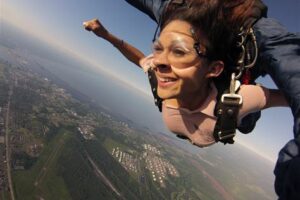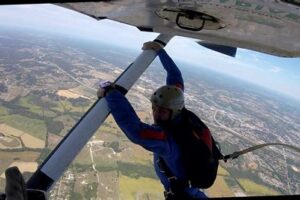Table of Contents
Learn about the weight limit for skydiving and find out if you meet the requirements. Discover the maximum weight allowed for tandem skydiving and understand the safety considerations involved. Whether you’re a thrill-seeker or have concerns about weight restrictions, this guide will provide valuable information to help you plan your skydiving adventure.
Skydiving is a thrilling adventure that pushes the limits of human courage and offers an incredible rush of adrenaline. However, before taking the plunge, it is crucial to understand that safety always comes first. One of the most important factors to consider when embarking on this exhilarating journey is the skydive weight limit. Determined by various factors, such as the type of parachute system being used and the individual’s body mass index (BMI), this weight restriction ensures optimal safety and enjoyable experience for all skydivers. So, let’s delve deeper into this topic and explore why adhering to the skydive weight limit is essential for a successful and unforgettable skydiving adventure.
The Importance of Skydive Weight Limit
Skydiving is an exhilarating sport that allows individuals to experience the thrill of freefalling through the sky. However, it is essential to understand that there are certain limitations and safety measures associated with this activity. One such restriction is the skydive weight limit, which ensures the safety of both the skydiver and the instructor. In this article, we will explore the significance of adhering to the skydive weight limit and the reasons behind it.
Understanding the Skydive Weight Limit
The skydive weight limit refers to the maximum weight that a person can have to participate in a skydiving activity. The weight limit varies from one skydiving center to another, but it typically ranges between 200-240 pounds (90-109 kg). This restriction is in place because excessive weight can increase the risks associated with skydiving, such as difficulties in parachute deployment, reduced maneuverability, and increased descent speed.
Parachute Deployment Challenges
One of the primary concerns associated with exceeding the skydive weight limit is the challenge of deploying the parachute safely. Parachutes are designed to handle a specific weight range, and exceeding this range can put undue stress on the equipment. When a skydiver is overweight, the force required to deploy the parachute can be significantly higher, potentially leading to malfunctions or delays in the chute opening.
Reduced Maneuverability
Another critical aspect affected by exceeding the skydive weight limit is maneuverability during the freefall and under the canopy. Skydiving requires a certain level of agility to control movements in the air and ensure a safe landing. Excessive weight can hinder a skydiver’s ability to maneuver, making it challenging to maintain stability during the freefall and control the descent under the canopy.
Increased Descent Speed
Exceeding the skydive weight limit can also result in an increased descent speed for the skydiver. The heavier the individual, the faster they will fall due to the force of gravity. This increased speed can make it more challenging to stabilize the body during the freefall and control the landing, potentially leading to injuries upon touch down.
Risk to Instructors
Adhering to the skydive weight limit is not only crucial for the safety of the skydiver but also for the instructors. Instructors are responsible for guiding and ensuring the safety of their students during the jump. If a student exceeds the weight limit, it can pose additional risks to the instructor, making it difficult to maintain control during the jump and potentially compromising the safety of both individuals.
Safety Precautions and Regulations
In order to maintain the highest level of safety, skydiving centers have established strict weight limits and regulations. These limits are determined based on extensive research, experience, and testing conducted by professionals in the field. It is crucial for both the skydiving center and the participants to adhere to these weight restrictions to ensure a safe and enjoyable experience for everyone involved.
Weight Restrictions and Health Considerations
The skydive weight limit is not intended to discriminate against individuals but rather to prioritize safety. Excessive weight can increase the risk of injury or complications during the jump. It is essential for potential skydivers to understand that weight restrictions are in place to protect their well-being as well as that of the instructors and other participants.
Working towards Meeting the Limit
If an individual exceeds the skydive weight limit but is determined to experience the thrill of skydiving, they can work towards meeting the requirements. Engaging in regular exercise, adopting a healthy lifestyle, and managing weight can be effective ways to gradually reach the desired weight. This approach ensures that the individual can fully enjoy the experience without compromising safety.
Conclusion
Understanding and respecting the skydive weight limit is crucial for the safety and well-being of everyone involved in this exhilarating sport. By adhering to the weight restrictions set by skydiving centers, individuals can ensure a safe and enjoyable experience while minimizing the risks associated with exceeding the weight limit. Remember, the skydive weight limit is not meant to discourage individuals but rather to prioritize safety and guarantee an unforgettable adventure in the skies.
Skydive Weight Limit: Ensuring Safe and Unforgettable Experiences
Skydiving is an exhilarating adventure that allows individuals to experience the thrill of freefalling from thousands of feet above ground. To ensure the safety of all participants, skydiving centers have established weight limits. In this article, we will explore the importance of weight restrictions in skydiving and provide insights into the factors that determine a safe and enjoyable skydiving experience.
1. Safety First: The Importance of Weight Limits
Skydiving weight limits play a crucial role in maintaining the safety of both the skydivers and the instructors. These restrictions are in place to ensure that the parachute systems can handle the weight and maintain proper functionality throughout the jump. By adhering to weight limits, skydiving centers can mitigate potential risks and ensure a successful and accident-free experience for all individuals involved.
2. Equipment Capacity: How Weight Impacts Parachute Performance
The weight of a skydiver directly influences the performance of the parachute system. Parachutes are designed to support a certain weight range, and exceeding this range can compromise the descent speed, stability, and overall control during freefall. By setting weight limits, skydiving centers can ensure that the parachute system operates optimally, allowing for a controlled and safe landing.
3. Ideal Body Position: Balancing Weight and Stability
Maintaining stability during freefall is crucial for a safe and enjoyable skydiving experience. Exceeding weight limits can make it challenging for skydivers to maintain the ideal body position required for stability, resulting in potential difficulties during the freefall and landing phases. Adhering to weight restrictions helps individuals achieve proper balance, leading to smooth and controlled flights.
4. Fatigue and Emergency Situations: The Impact of Excess Weight
Exceeding weight limits can significantly increase the fatigue experienced by both the skydiver and the instructors. Fatigue can impair decision-making, reaction times, and overall performance, increasing the risk of accidents or mishaps during emergency situations. By respecting weight restrictions, skydivers can reduce the likelihood of fatigue-related incidents, making their experience safer and more enjoyable.
5. Weather Conditions: Weight Limits and Atmospheric Factors
Weather conditions play an important role in determining safe skydiving operations. Wind speed, air density, and other atmospheric factors can vary based on weight. Abiding by weight limits helps skydiving centers and instructors make informed decisions regarding jump feasibility and ensures that individuals experience optimal conditions while soaring through the sky.
6. Personal Comfort: Enhancing the Skydiving Experience
Maintaining weight limits is not only about safety but also about personal comfort. Skydiving is an adventure that requires individuals to be physically and mentally prepared, as well as comfortable in their equipment. By adhering to weight restrictions, participants can enjoy a more pleasant skydiving experience, free from excessive strain or discomfort caused by exceeding the recommended limits.
7. Individual Assessment: The Importance of Honesty and Communication
It is essential for skydivers to disclose their accurate weight during the registration process. Skydiving centers rely on this information to properly assess whether individuals fall within the weight limits specified for their particular equipment. Honesty and open communication allow instructors to provide personalized guidance based on individual circumstances and ensure a safe and customized experience for all participants.
8. The Journey Towards an Unforgettable Experience
By respecting skydive weight limits, individuals contribute to the overall safety, enjoyment, and success of their skydiving experience. Whether it’s the adrenaline rush of freefall or the awe-inspiring views during descent, adhering to weight restrictions ensures that every moment in the air is filled with exhilaration and unforgettable memories, creating a truly remarkable adventure.
In the world of skydiving, safety is of utmost importance. Every aspect of the sport is carefully regulated and monitored to ensure the well-being of both participants and instructors. One crucial factor that is considered before taking to the skies is the weight limit for skydiving.
1. Protecting participants:
Skydiving can be an exhilarating and life-changing experience, but it also carries inherent risks. The weight limit exists to protect participants from potential dangers that may arise due to excessive weight. By setting a maximum weight, operators can ensure that the parachute system is capable of safely supporting the individual’s mass throughout the entire skydive.
2. Maintaining equipment integrity:
The weight limit also serves to preserve the integrity of the skydiving equipment. Parachutes are designed and manufactured to withstand certain loads, and exceeding these limits could compromise their performance and increase the risk of malfunctions. Adhering to the weight limit helps to maintain the reliability and effectiveness of the equipment, ensuring a safe skydiving experience.
3. Ensuring instructor capability:
Skydiving instructors play a vital role in guiding participants through their jumps. They are responsible for not only the participant’s safety but also their own. A weight limit allows instructors to assess their ability to manage the additional weight during freefall and landing. This ensures that the instructor can maintain control and execute proper procedures in case of any unexpected circumstances.
4. Minimizing risk:
By establishing a weight limit, the skydiving industry aims to minimize the overall risk involved in the sport. Exceeding the weight limit could lead to increased descent speeds, reduced maneuverability, and potentially dangerous landings. By adhering to the weight limit, skydivers can enjoy a safer experience with a reduced likelihood of accidents or injuries.
5. Industry standardization:
Establishing a weight limit allows for industry standardization across different skydiving operations. This consistency ensures that skydivers can expect similar safety protocols and procedures regardless of the location they choose to pursue their passion. It also allows for effective communication between skydiving professionals and enables the sharing of best practices to enhance safety measures.
In conclusion, the weight limit for skydiving is an essential component of ensuring participant safety, protecting equipment integrity, enabling instructor capability, minimizing risk, and promoting industry standardization. By adhering to these limits, both experienced skydivers and newcomers can enjoy the sport with peace of mind, knowing that every precaution has been taken to prioritize their safety.
Thank you for taking the time to visit our blog and learn more about the skydive weight limit. We understand that this topic is of great importance to many individuals who are considering taking part in this exhilarating adventure. In this closing message, we aim to summarize the key points discussed throughout the article and provide you with a comprehensive understanding of the weight restrictions associated with skydiving.
First and foremost, it is crucial to acknowledge that weight limits exist for the safety and well-being of both the participants and the skydiving professionals. The equipment used during a skydive is designed to support a specific weight range, ensuring that it functions effectively and minimizes the risk of accidents. By adhering to these weight limits, skydiving centers can provide a secure and enjoyable experience for all individuals involved.
Secondly, it is important to note that weight restrictions can vary among different skydiving centers. While some facilities may have a maximum weight limit of 200 pounds, others might accommodate individuals weighing up to 250 pounds or more. It is essential to check with your chosen skydiving center beforehand to ensure that you fall within their specified weight range. By doing so, you will avoid any disappointment or inconvenience on the day of your scheduled jump.
In conclusion, we hope that this article has provided you with valuable insights into the skydive weight limit. We understand that weight restrictions may seem restrictive to some individuals, but it is crucial to prioritize safety in such adrenaline-fueled activities. By adhering to the weight limits set by skydiving centers, you can ensure a smooth and secure experience that allows you to fully enjoy the thrill of freefall and the breathtaking views from above. If you have any further questions or concerns, we encourage you to reach out to your chosen skydiving center for clarification. Happy skydiving!
.
People also ask about Skydive Weight Limit:
-
What is the weight limit for skydiving?
The weight limit for skydiving varies depending on the specific skydiving center and the type of equipment they use. However, most centers have a weight limit of around 220-230 pounds (100-105 kilograms) for tandem skydiving. It’s important to check with the skydiving center beforehand to confirm their specific weight restrictions.
-
Why is there a weight limit for skydiving?
The weight limit for skydiving exists primarily for safety reasons. The limits are in place to ensure that the parachute system can safely support the weight of the jumper during freefall and landing. Going beyond the weight limit could put excessive strain on the equipment, potentially compromising its effectiveness and increasing the risk of accidents.
-
Can I skydive if I’m over the weight limit?
Unfortunately, if you exceed the weight limit set by a skydiving center, it may not be possible for you to participate in a tandem skydive. Exceeding the weight limit could pose a safety risk both to you and the instructor you would be jumping with. However, some centers offer specialized programs or equipment for heavier individuals, so it’s worth inquiring about alternative options.
-
What if I am just slightly over the weight limit?
If you are only slightly over the weight limit, some skydiving centers may still allow you to jump after assessing your physical fitness and evaluating the specific circumstances. In such cases, the decision ultimately rests with the instructor and the center’s policies. It’s always best to have an open and honest conversation with the skydiving center to discuss your situation and explore any potential options.
-
Are there any other requirements besides the weight limit?
Yes, besides the weight limit, there may be additional requirements for skydiving. These requirements can vary between different skydiving centers but commonly include age restrictions (usually 18 years or older), physical fitness, and signing a liability waiver. It’s crucial to check with the specific center you plan to skydive with to ensure you meet all the necessary criteria.






